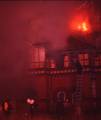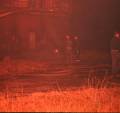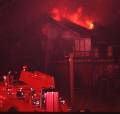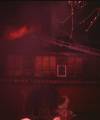

- Anne Hale: The Case of the Communist Teacher
- Baseball: A Way of Life
- Chuck Taylor Hightops: WHS Basketball
- The Baby Boom Explodes
- "Mrs. Everywoman"
- Warriors Football
- Nightlife Up in Smoke: The Mansion Inn
- Not-So-Fast-Times at Wayland High
- The Sirens of Wayland: The Police Department
- Cold War Wayland: Nike Missile Site & Raytheon
- Keeping Up wit the Joneses: Consumerism in the Town Crier
- A Sense of Community: The Strawberry Festival
- Newsletters to Those at War: The Bugle and the Jeep
- A Quieter Life: Coming Home from World War II
- Duty Calls: Veterans of the Korean War
- A Simpler Time: Growing Up in Wayland
- Old Meets New: Dudley Pond
- Flash Movie

Nightlife Up in Smoke: The Mansion Inn
2004 Local Historians: Danielle Fernandes and Amanda Pond
 built the Inn originally as
the residence for his young bride with the last name Marrs. The Victorian
beauty later functioned as an Inn, a restaurant, and a dance hall as well. Large
scale events took place there. People came to spend time with friends,
dance, or just listen to the live music. Many memories were made at this
glorious place, now but fond reminiscences of a lost time at the old
Cochituate landmark.
built the Inn originally as
the residence for his young bride with the last name Marrs. The Victorian
beauty later functioned as an Inn, a restaurant, and a dance hall as well. Large
scale events took place there. People came to spend time with friends,
dance, or just listen to the live music. Many memories were made at this
glorious place, now but fond reminiscences of a lost time at the old
Cochituate landmark.
In 1956, however, this grand old inn met its end in a conflagration
that echoes in the memories of Wayland's older population. As the historic
building went up in smoke on a cold March day, it signaled an end of an era in
town. Despite a brief effort to rebuild, the plot of land would instead
serve as the site of the latest residential development. In the same way
that area farms and open land were being turned into subdivisions to
accommodate the population burst, developers constructed fourteen 1950's
style homes on the site. The new bedroom-community that would be the Wayland of the
latter half of the 20th century was upon us and the the Mansion Inn was
becoming a mere memory gone up in smoke.

Mr. John C. Bryant, a longtime resident of Wayland, tells us about some recollections he has of the Mansion Inn. Although he wasn't quite old enough to enter the Inn at the time, he shares with us his stories as a kid curiously peering through the windows. During an interview on May 23, 2004, Mr. Bryant had these comments to share:
It [The Mansion Inn] was no question the most elegant structure in the town of Wayland- I would say that without reservations. It was made from very magnificent imported marble from Italy. The architectural design was very, very unique. It was a huge building made of brick, marble, sandstone, and granite. Marrs [The young bride that first lived in the Inn] lived in a beautiful mansion surrounded by luxury. There were four magnificent lions; granite lions that were in front of the Mansion Inn- some were crouching down, some were sanding very erect. We [Mr. Bryant and his friends] would crawl all over them and enjoy ever bit of it.When asked to describe the atmosphere of the Inn, he replied:
Well, it's been known that there were activities that are probably not accepted in society today. It was more of a night-club atmosphere where adults would dance and drink there. The dance hall was elegant, absolutely elegant. It had a walkway and tables all around the dance floor. It was very upbeat. Many functions were held there--huge, huge activities. Big bands at that time would play there, but they had their own orchestra also. There was mostly contemporary dance music you wouldn't dance to today!After asking Mr. Bryant of his fondest memories of the Mansion Inn he stated:
Running up the terraces and rolling down them. As a kid we used to catch huge bull frogs at Dudley Pond and sell the back legs to the Mansion Inn and they would give us 8 or 10 cents a leg, because frogs legs were and sill are a real delicacy. We sat on the grass around the edges to watch the wrestlers. That was the entertainment in those days.Unfortunately, the Mansion Inn is not yet around for our generation to enjoy. On May 24, 1956, the Mansion Inn went up in flames in the third big snowstorm of the spring season. It was said that smoke had risen from the basement, and within minutes the old wooden structure was a raging inferno. A place that had stood for so long was gone almost instantly. Mr. Bryant watched as the fire devoured this unforgettable piece of history. He recalls: "You could feel the heat. It was a terrible, terrible, destructive fire. It was a landmark that dated way, way, way back to the history of Cochituate. It was disastrous." The damage was estimated at $100,000. After the blaze, the question arose about replacing the now empty lot. Some thought they should rebuild the restaurant, others thought the space would make a fine town park. However, these proposals proved to be too costly. The days of dancing and dining were over, and with the booming population of the times, what was once the happening place in town was replaced with a residential development along, appropriately, Simpson Road and Mansion Road. The Mansion Inn represents common nightlife in the 1950s: the fun-filled nights dancing to swing music, dining on 75¢ plates of Risotto Milanais, sipping 40¢ Mansion Inn High Balls, and puffing away on one of the 30 brands of cigars and cigarettes. They're now but fond memories of the good old days-- times that went up in flames.

Mrs. Jo Wilson recalls the Inn as well:
What I remember [is that] it had been someone's home and it had been added onto. The Inn gained its reputation during prohibition days. It carried sort of mysterious essence; it was exciting to go there, but very dark inside. I went to two dances there, and when an organization put on a dance; they decorated the whole place. . . In my recollection the Inn accented less on food more on drinks. It wasnt a Friendlys. . . It always had that aura of mystery because it was hidden away. . . In most people's minds, Wayland was country- it was the woods (the boonies). Many outsiders came from neighboring areas such as Boston, and Newton because the Mansion Inn had the reputation of being a speakeasy of sorts. In retrospect the Mansion Inn never fully became known as a speakeasy but was rebellious enough to serve alcohol when prohibition had deemed it illegal. The same things were said about Sandy Burr. I never saw or recognized anybody at the Mansion Inn who was under-age, it wasnt a place for younger generations to hang out. . . When I was there at a function, like at a dance where you paid money ahead of time, it was all young adults.It seems to me the Mansion Inn had a glittery, dark, metallic look to it." Mrs. Wilson recalls feeling that the place was a lot different from other places she had been to. "It was sort of a mysterious atmosphere, negative feelings. Women would get very dressed up to go to the dance functions at the Mansion Inn. In those days young ladies didnt wear pants, women wore skirts and heels. . . I wouldn't be surprised if big bands touring by bus would occasionally stop and play at the Mansion Inn. There were no DJs. Local bands, four or five piece bands would play at the Mansion Inn. The larger bands often played on route 9 in Framingham."


One time Mrs. Wilson visited the Mansion Inn because she was on the board of health completing a food inspection at the Inn and "it did not pass the inspection."
"There was a great deal of controversy over what would be done with the land after the Mansion Inn burned down." Mrs. Wilson informed us that Castle gate was the Mansion Inns original entrance. ģIt wasnt a controversial building, it was part of the scenery. There was a feeling that it was desirable. The entrance symbolized the old; [it was] Victorian style.Mrs. Wilson didn't live in Wayland during the times of prohibition, but she recalled hearing the Mansion Inn had the reputation of breaking the law during the years of prohibition. "The reputation stays, no matter if theyre not doing it anymore. . . The illegality it just never really shook. I think people were astonished by the speed of the fire." Mrs. Wilson explained that Wayland did not have a full time fire department; firefighters were called during times of emergency. After the mansion had burned down a fire station was established. After the Mansion Inn fire, Wayland was more concerned with establishing a 24-hour fire station which proved to be far more effective then a volunteer fire department."I remember hearing about the fire at night because we were asleep. The Firefighters water was freezing and they were having a terrible time putting it out. . . It was an exciting moment because nothing like that had ever happened."

Mrs. Wilson spoke of how after the fire and before building had begun Indian remains were found underneath the foundation of the Mansion Inn. She says no one knew about the artifacts until long after the building had burned down. There were no archeologists to keep people away so that they wouldnt disrupt the site. ģIt was anyones field day, "People came and looked through the rubble for Indian remains. No body thought that they were breaking any laws. They were on somebody elses property so in a sense they were, but back then it wasnt such a big deal as it would have been now. Unfortunately those Indian artifacts have been lost forever in one of the scavengers attics."
 Mr. Paul Kohler, a young
employee at the Inn in the 1950's, has a different perspective on the
Mansion Inn. "It was one of the fanciest buildings I had ever seen. When
you pulled up to the front door, carriages would pull up under an archway,
and it had a cover so the ladies wouldnt get wet in the rain. Through the
front door you stepped into a foyer. It was a big room with a tall balcony
around the top. Underneath the balcony was a lot of hand-carved wood. The
walls were gold leafed; it was a gorgeous room. A lot of brides and grooms
had their wedding receptions at the Mansion Inn because of its beautiful
facility. People took their pictures in front of the fireplace with the big
urns that were taller than you are." Paul Kohler jokes that there weren't
any flowers with stems long enough to put in the urns.
The Inn was not very well lit. There were candles, dim lights
(electrified lanterns), and the room was made of dark wood. The Mansion Inn
was comprised of many rooms that served many different purposes. Mr. Kohler
confirmed that the Mansion Inn was strongly associated with drinking. "The
Mansion Inn was well known amongst the drinking population. When Bostonians
and Newtonites wanted to get away they would come to Cochituate to dine and
dance at the Mansion Inn." Mr. Kohler was also present at the Mansion Inn
was burning. He was able to take several photographs and has spectacular
footage of the flames. Mr. Kohler suspected that the reason the Mansion Inn
burned so rapidly had to do with the building structure. Paul Kohler
reiterates John Bryants words as he claims that the fire would have spread
less rapidly had fire stops been installed in the building. Generally fire
stops were placed between the basement and the first floor, but the Inn did
not have any fire stops at all.
Mr. Paul Kohler, a young
employee at the Inn in the 1950's, has a different perspective on the
Mansion Inn. "It was one of the fanciest buildings I had ever seen. When
you pulled up to the front door, carriages would pull up under an archway,
and it had a cover so the ladies wouldnt get wet in the rain. Through the
front door you stepped into a foyer. It was a big room with a tall balcony
around the top. Underneath the balcony was a lot of hand-carved wood. The
walls were gold leafed; it was a gorgeous room. A lot of brides and grooms
had their wedding receptions at the Mansion Inn because of its beautiful
facility. People took their pictures in front of the fireplace with the big
urns that were taller than you are." Paul Kohler jokes that there weren't
any flowers with stems long enough to put in the urns.
The Inn was not very well lit. There were candles, dim lights
(electrified lanterns), and the room was made of dark wood. The Mansion Inn
was comprised of many rooms that served many different purposes. Mr. Kohler
confirmed that the Mansion Inn was strongly associated with drinking. "The
Mansion Inn was well known amongst the drinking population. When Bostonians
and Newtonites wanted to get away they would come to Cochituate to dine and
dance at the Mansion Inn." Mr. Kohler was also present at the Mansion Inn
was burning. He was able to take several photographs and has spectacular
footage of the flames. Mr. Kohler suspected that the reason the Mansion Inn
burned so rapidly had to do with the building structure. Paul Kohler
reiterates John Bryants words as he claims that the fire would have spread
less rapidly had fire stops been installed in the building. Generally fire
stops were placed between the basement and the first floor, but the Inn did
not have any fire stops at all.
 Mr. Kohler explains that water was pumped out of Dudley Pond into a
water tower. That was where the Mansion Inn got its water supply. "We did not
have running water in Cochituate at the time." Mr. Kohler's mother worked in
the kitchen of the Mansion Inn, while he worked as a dishwasher and his
brother was a bus boy, both of them earning 15-20 cents and hour. His
brother would also check hats and chat with the guests as she did her work.
There was a bar around the lounge that was closed in. Mr. Kohler explains
how one of the patios was enclosed in order to make the facility larger.
Mr. Kohler explains that water was pumped out of Dudley Pond into a
water tower. That was where the Mansion Inn got its water supply. "We did not
have running water in Cochituate at the time." Mr. Kohler's mother worked in
the kitchen of the Mansion Inn, while he worked as a dishwasher and his
brother was a bus boy, both of them earning 15-20 cents and hour. His
brother would also check hats and chat with the guests as she did her work.
There was a bar around the lounge that was closed in. Mr. Kohler explains
how one of the patios was enclosed in order to make the facility larger.
Mr. Kohler has pictures of two statues of lions that were located outside the front entrance of the Mansion Inn. Many young children used to play and climb on these lions. Mr. Kohler even has a picture of his brother sitting on one of the lions. Mr. Kohler always remembers when he was a child how his mother giving him the left over lobster from the dinner she would prepare at the Mansion Inn. "This is not the place that I would take anyone out to dinner, it was a little out of my league, financially."
 As the building was burning the manager of the Inn offered the
onlookers the steak, which was left inside the building, he joked, and said
"they're probably pretty well cooked by now.!" Mr. Kohler believes that the
fire may not have started in the kitchen, but could have started anywhere
and was so devastating because of its construction, "once the fire got going
it could not be stopped. The only thing that people could do was keep the
fire from spreading to neighboring
buildings." The firefighters were very helpful and they tried all that they
could do. "As I recollect they determined it was an electrical fire."
As the building was burning the manager of the Inn offered the
onlookers the steak, which was left inside the building, he joked, and said
"they're probably pretty well cooked by now.!" Mr. Kohler believes that the
fire may not have started in the kitchen, but could have started anywhere
and was so devastating because of its construction, "once the fire got going
it could not be stopped. The only thing that people could do was keep the
fire from spreading to neighboring
buildings." The firefighters were very helpful and they tried all that they
could do. "As I recollect they determined it was an electrical fire."
Surrounding the dance floor was a dining area. "The dance floor itself was on springs." The more people danced the more the floor sunk preventing water glasses from shaking and disruption in the dining area. Mr. Kohler remarks that the people got very dressed up to go dancing there. The first night Mr. Kohler went to the Mansion Inn was with his wife Joanne when he was home on leave from the military and he recalled having a wonderful time. His second visit to the Inn was on New Year's Eve where he celebrated with a bunch of his friends from Brighton. He remembers at the end of the night when it closed around 1:00 AM, so his friends went back to his house and partied for the remainder of the night. On regular night the Mansion Inn was open until midnight. "There were locals there, but a lot of people came from out of town. It was well known in the Middlesex area."
The coach house was another outstanding building separate from the Mansion Inn that once housed horses. It also caught on fire almost a year later on Halloween, 1957. The owner of the Mansion Inn wanted to put up a new restaurant not as fancy as the old Inn. He wanted a new establishment to replace the catastrophe that lay before them. Critics complained, however, maintaining that "It's so noisy; that was a joke. It was not a noisy place," states Mr. Kohler.
 Longtime resident Mr. Lew Russell, owner of Russell's near Wayland
center told us his view of the Mansion Inn as he was growing up. The Mansion
Inn was definitely associated with drinking, and since his parents believed
in prohibition they never went there. Back when he was growing up his
parents made him believe that drinking wasnt accepted and they didn't like
the reputation of drinkers. In the 1920's, the people who went there
strictly went to drink against the law, and even after the end of the
prohibition the Inn still had that reputation.
Longtime resident Mr. Lew Russell, owner of Russell's near Wayland
center told us his view of the Mansion Inn as he was growing up. The Mansion
Inn was definitely associated with drinking, and since his parents believed
in prohibition they never went there. Back when he was growing up his
parents made him believe that drinking wasnt accepted and they didn't like
the reputation of drinkers. In the 1920's, the people who went there
strictly went to drink against the law, and even after the end of the
prohibition the Inn still had that reputation.
Mr. Russell remembers being three miles away from the Mansion Inn on the day of the fire and he could smell the smoke as he stepped onto his porch. He didnt know why the Mansion Inn burned down. He said to believe that it was caused by an electrical fire. He told us that many townspeople went to take pictures and to help out with the fire as the Inn was burning down.
 Mr. and Mrs. MacKay were Wayland residents in the 1950s, and were
able to recall some of the times they spent at the Mansion Inn. Louis
MacKay shared with us that her husband had taken her there twice to go
dancing. She recalls eating on a balcony above the dance floor at a table
that was close to the railing of the balcony so she could look out onto the
dance floor.
Mr. and Mrs. MacKay were Wayland residents in the 1950s, and were
able to recall some of the times they spent at the Mansion Inn. Louis
MacKay shared with us that her husband had taken her there twice to go
dancing. She recalls eating on a balcony above the dance floor at a table
that was close to the railing of the balcony so she could look out onto the
dance floor.


























































